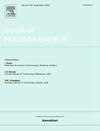New capabilities for rapid depletion analysis of pebble-bed reactors in SCALE
IF 2.3
3区 工程技术
Q1 NUCLEAR SCIENCE & TECHNOLOGY
引用次数: 0
Abstract
The SCALE Leap-In for Cores at Equilibrium (SLICE) method leverages capabilities available in the SCALE modeling and simulation suite to facilitate rapid estimation of equilibrium core inventories for flowing-pebble reactor systems in support of a variety of fuel cycle applications. New capabilities that compliment the SLICE method have been developed for the ORIGAMI interface to ORIGEN in SCALE to facilitate rapid depletion calculations for flowing-pebble systems. New features include a more generalized and flexible means of specifying interpolation dimensions, the ability to evaluate pebbles moving through user-defined “axial zones” in each of the pebble’s multiple passes through the core, and the treatment of differential velocities across radial channels (representing both pebble-to-pebble and wall-to-pebble friction effects). ORIGAMI thus provides an efficient user interface to define a pebble’s path and irradiation histories of its multiple passes through the core to calculate the pebble’s time-dependent inventories, which can be useful in various applications domains such as safeguards, criticality safety, and disposal analyses. The consistency of new ORIGAMI approach was verified against the solution obtained using the SLICE method with ORIGEN-ARP, showing excellent agreement.
SCALE中球床反应器快速耗尽分析的新功能
SCALE平衡堆芯跨进(SLICE)方法利用SCALE建模和仿真套件的功能,促进流球反应堆系统平衡堆芯库存的快速估计,以支持各种燃料循环应用。为配合SLICE方法,ORIGAMI与ORIGEN在SCALE中的接口开发了新的功能,以促进流动卵石系统的快速耗尽计算。新功能包括一种更通用和灵活的方法来指定插值尺寸,能够评估鹅卵石通过用户定义的“轴向区域”的能力,以及在径向通道上的差分速度处理(代表鹅卵石对鹅卵石和墙对鹅卵石的摩擦效应)。因此,ORIGAMI提供了一个高效的用户界面来定义卵石的路径和多次通过堆芯的辐照历史,以计算卵石的时间依赖性库存,这在各种应用领域都很有用,如保障、临界安全以及处置分析。将新方法与基于ORIGEN-ARP的SLICE方法得到的解进行了一致性验证,显示出良好的一致性。
本文章由计算机程序翻译,如有差异,请以英文原文为准。
求助全文
约1分钟内获得全文
求助全文
来源期刊

Annals of Nuclear Energy
工程技术-核科学技术
CiteScore
4.30
自引率
21.10%
发文量
632
审稿时长
7.3 months
期刊介绍:
Annals of Nuclear Energy provides an international medium for the communication of original research, ideas and developments in all areas of the field of nuclear energy science and technology. Its scope embraces nuclear fuel reserves, fuel cycles and cost, materials, processing, system and component technology (fission only), design and optimization, direct conversion of nuclear energy sources, environmental control, reactor physics, heat transfer and fluid dynamics, structural analysis, fuel management, future developments, nuclear fuel and safety, nuclear aerosol, neutron physics, computer technology (both software and hardware), risk assessment, radioactive waste disposal and reactor thermal hydraulics. Papers submitted to Annals need to demonstrate a clear link to nuclear power generation/nuclear engineering. Papers which deal with pure nuclear physics, pure health physics, imaging, or attenuation and shielding properties of concretes and various geological materials are not within the scope of the journal. Also, papers that deal with policy or economics are not within the scope of the journal.
 求助内容:
求助内容: 应助结果提醒方式:
应助结果提醒方式:


